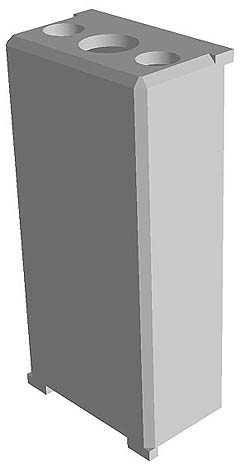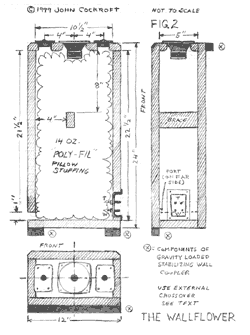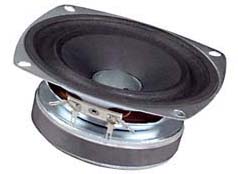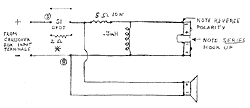| The Wallflower
by John Cockroft / Copyright 2000 All Rights Reserved |
|
| The Wallflower is an outgrowth
from my answer to a letter in SB from reader David J. Meraner (SE 1/99 and 5/99).
In the letter I speculated upon modifying a paralleled inductor crossover that I
had presented by eliminating the capacitor and by using 2 tweeters in a series configuration
which doubled the impedances but left the sensitivity of the tweeter pair the same
as that of a single tweeter. (Going from 8 ohms to 16 ohms causes a 3 dB loss. 2
speakers in close conjunction create a 3 dB gain.) A couple of years ago SB reader and electrostatic speaker designer (and friend) Barry Waldron wanted me to design him a center speaker for a home theater system he was contemplating (but which never materialized). I had planned to use a D'Appolito MTM system turned on its side for the center speaker (Doesn't everyone?) It was to be incorporated into a symmetrical form of my Freeline (SB 5/95) (The upper and lower lines, in this case, the right and left lines, were to be the same length and have the same stuffing density.) Because Barry had presented me with a constraint in the width dimension it didn't seem practical to me to try to fit in 2 woofers. I decided to use 2 tweeters and 1 woofer. I really decided to use this when friend and fellow speaker builder Bob Baldwin said it wouldn't work that way because "it was a matter of spacing". It worked out fine. Barry didn't get the center speaker. I liked it too much. (Besides he never built the rest of his system. When he does he can have it...I think.) I liked it better in a vertical position. I liked it best up against the wall, on its back, facing up with the driver faces about 2 to 3 ft from the floor. |
|
| After that it was only
natural that I should use this format when I designed the Wallflower. The wideness
of the enclosure gives it the stability it needs to keep from falling over on its
sides. This wideness is also required to allow the use of two tweeters. This wideness
isn't required for the quality of sound, but it doesn't hurt it. The other Simplines
were very happy with a cross section of half this area and very probably could have
gotten by with a bit less. Their cross sections also were dictated by other restrictions
than that required for their breathing. Their cross sections were the smallest size
that could reasonably allow their woofers to nestle comfortably in their top ends.
This kind of stuff goes on every day in the circus pit of loudspeaker system design.
Wal-mart makes out. He gets to sell you a bit more "Poly-Fil'' to maintain the
proper stuffing density in the larger volume. Essentially this is a smallish system
so a certain amount of ballooning can be endured. And what the heck, it looks more
like a speaker system than the other Simplines. While the extra width was great for side sway it did nothing for the very narrow depth of the enclosure. When I built the prototype and set it up to the wall it had about the same stability as a cork floating in a swimming pool. On a carpet and set out in front of the base board the Wallflower did very little to encourage my belief that these could be great speakers. Then there was the 3/4" gap between the top of the enclosure and the wall which changed dimensions each time I trod on the carpet in close proximity to the enclosure. Not good. |
<clik image for larger figure> |
| The first thing I did
was to glue a spacer strip on the back panel, flush with the top panel. This gave
a bridge to the wall. (I find it very encouraging to find that some bridges still
lead elsewhere than to the 21st century). The enclosure could now be pushed
up against the wall where it just passively sat without any real pressure stabilizing
the contact. I tried pushing the bottom a bit closer to the wall than the top, hoping
it would try to straighten up and push the top in. A bit better but not world class
by any means. What finally worked quite well was the placing of a 3/4" x 3/4" support cleat along the bottom edge of the front panel, forming a sort of 12" wide monopod. This gives a pad of about 9 in2 to support a 21 pound enclosure (if you decide to line the inside of the enclosure with the optional stiffening and damping compound I recommend.) Things are further secured by the fact that most of the weight is located behind the support cleat which is the only connection to the floor. This supplies a torquing motion which forces the top spacer to the wall. This seems to me the next best thing short of the old Sampling lean. Actually the Wallflower is still a leaner. It leans because a line drawn between the support cleat and the rear of the top spacer forms the hypotenuse of the triangle completed by the wall and the floor. I refer to this marvel of conceptual engineering as the Gravity Loaded Stabilizing Wall Coupler (GLSWC). For even more security a couple of spikes might be placed along the front bottom in place of the support cleat. Actually I compromised. I used 2 cleats, 2" long, coming in from the outer edges of the enclosure instead of the single 12" one. I figured this would give a smaller footprint(s) which would give more coupling pressure as well as allowing better stability on unflat floors. This coupling system actually holds the enclosure more tightly to the wall than the original Simplines with their obvious leaning posture. With this type of wall/floor/enclosure coupling and the fact that the speakers are firing upward, doppler distortion should be greatly minimized. A cone that weighs a few grams is trying to lift a 21 pound enclosure off the floor or is trying to drive the enclosure through the floor. |
|
| As with all of the Simplines since the beginning 13 years ago, the Wallflowers use the 4" Radio Shack 40-1197 "full range" speaker (editor: a version of the Fostex FE103), which I have modified by adding 2 coats of white glue to the front of the cone and the dust cap and additional mass in the form of lead weights. The tweeters are the same as the tweeter on the original Super Simpline, only now 2 tweeters are used. Additionally (as mentioned somewhere above) all 3 speakers are modified with the addition of Bondex Ready Mixed Concrete and Mortar Patch on their magnet structures. This is covered in an appendix. |
|
|
|
|
| I built the external "crossover" (It's really only a high pass filter.) in a small aluminum chassis box, because I had one. A similar box made from Masonite or 3/8" particle board would probably do as well. One crossover is required for each Wallflower. In addition to the actual high pass filter I added a switchable 2 ohms series resistance to the input of the Wallflower. I used this for impedance reasons on the Super Simplines, but it also improved the quality of their sound. They are not needed on the Wallflowers, but I feel that at least at times the added impedance, by raising Qts, does enhance the sound of the Wallflowers. |
<clik image for larger figure> |
| The speakers should be
set up vertically against the listening wall with the spacer cleat pressed against
the wall. You might try 6 ft to 8 ft between centers. The worst case would be to
have the center of the Wallflowers 2 ft from the side walls as this is the height
of the speaker. This could cause a cancellation dip at some frequency. It would be
better to alter the spacing width or perhaps raise the speaker a few inches off the
floor on something like a cinder block, or the support cleats could be replaced with
cleats several inches high. In this case it might give a better appearance if a single
12" wide board was used. Better yet, cut the front panel longer to start with.
This would also give you a space to hide the crossover behind in case you didn't
want to have it in a separate box. The listening chair position is pretty much non-critical.
The front of my listening chair is about 9 ft from the speakers. There is good listening
all over the room, sitting, standing or sitting on the floor. If you are using a receiver, set the 2 ohm series resistance switch to in position, otherwise set it to the out position. (The reason for this is that most receivers have power supplies on the light side so the assorted components on a single chassis won't mutually cook one another.) Ooops! I forgot to tell you to hook up the external crossovers to the Wallflowers. This helps. Especially if you like to listen to music. Now you are ready to listen to music. Just listen for awhile until your system is warm enough to stabilize. Then you can begin to listen critically. You might try listening with the series resistance in the line even if you are using a relatively high current amplifier, just to see how it sounds. I hope this is the start of a long term love affair with the Wallflowers. In closing I would like to thank Vince Bruzzese of Totem Acoustic (Formerly Totem Acoustique) who first piqued my interest in paralleled inductor high pass filters. He's a great guy and a designer of great sounding loudspeakers. |
|
|
[ Back to Projects | Contents | The Wallflower | Assembly | Parts | Epilog | Appendix ] |
|



